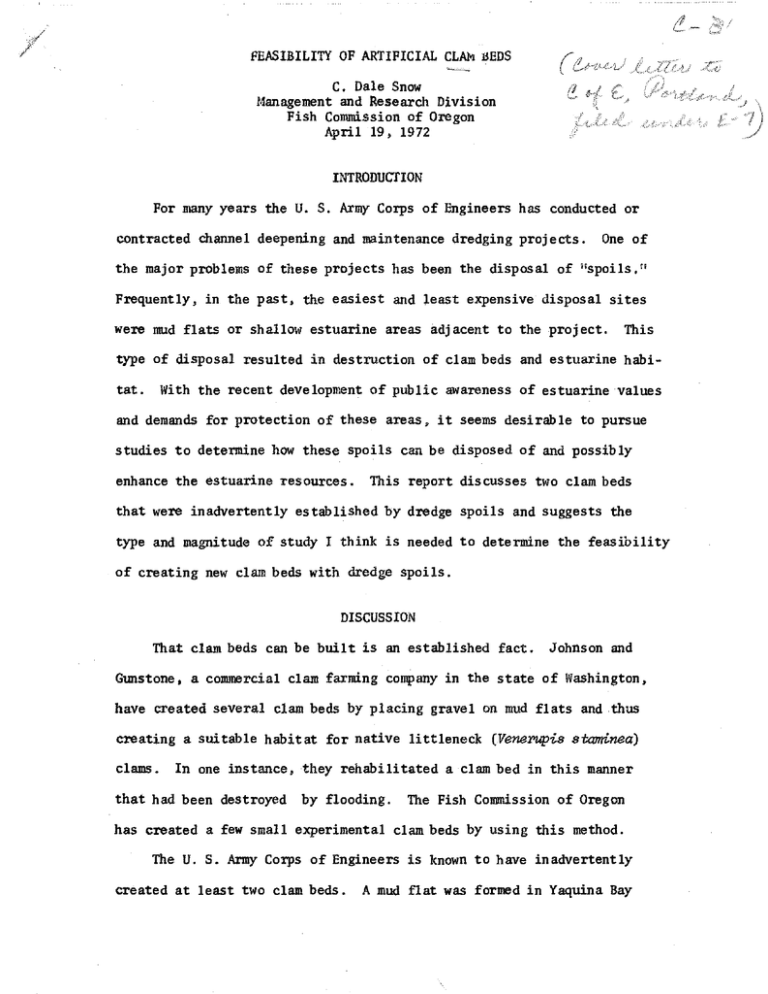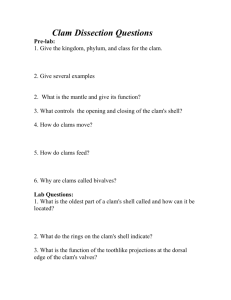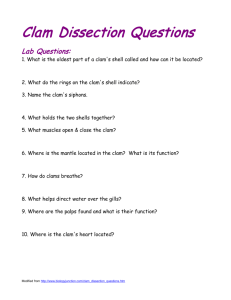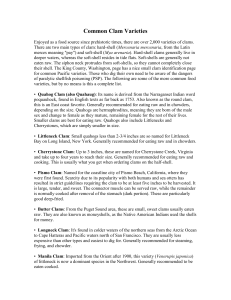/
advertisement

/ !- 3r/ t FEASIBILITY OF OF ARTIFICIAL ARTIFICIALCLAM CLAl~ BEDS BEDS [4 C. Dale Snow Snow C. Dale Management and Management andResearch Research Division Division Fish Commission Commission of Oregon Oregon 1 April 19, 1972 1972 April 19, INTRODUCTION For yearsyears the U. the S. Army of Engineers or Formany many U. Corps S. Army Corpshasofconducted Engineers contracted channel channel deepening deepening and and maintenance maintenance dredging dredgingproj projects. ects. One One of the major problems the major problemsofofthese theseprojects projectshas hasbeen beenthe thedisposal disposal of of "spoils." Frequently, the easiest easiest and and least least expensive expensive disposal Frequently,inin the the past, past, the disposal sites sites were mud were mudflats flats or or shallow shallowestuarine estuarine areas areas adjacent adjacentto to the the project. This type disposal resulted resulted in in destruction destructionof ofclam clam beds beds and and estuarine habitype of disposal tat. tat. With the development of With the recent development of public public awareness awarenessof of estuarine estuarine values and seems desirable desirab Ie to to pursue pursue and demands demandsforforprotection protectionofofthese theseareas, areas, it it seems studies to to determine determine how how these can be disposed disposed of and and possibly possibly these spoils can enhance enhancethe the estuarine estuarine resources. This discusses two two clam clam beds beds This report discusses that were were inadvertently established by by dredge dredge spoils and and suggests suggests the type type and and magnitude magnitudeofofstudy studyI Ithink thinkisis needed neededtoto determine determinethe thefeasibility feasibility of creating creatingnew new clam clam beds dredge spoi1s. spoils. beds with with dredge DISCUSSION That an established That clam clambeds bedscan canbebebuilt builtisis an established fact. and Johnson and ofWashington, Washington, Gunstone, commercial clam Gunstone, aa commercial clam farming farming company companyininthe thestate state of have clam beds beds by on mud mud flats and thus thus have created several clam by placing gravel on flats and creating littleneck (Venerupis (Vene1'Upis staminea) creating aa suitable suitable habitat habitat for native littleneck clams. clans. In one one instance, instance, they they rehabilitated rehabilitatedaaclam clam bed bed in in this thismanner manner that had had been been destroyed destroyed by by flooding. The Commission of ofOregon Oregon that The Fish Fish Connission has created created aafew few small small experimental experimental clam clam beds beds by by using this this method. method. Army Corps known to The The U. U. S. S. Army CorpsofofEngineers Engineersisis known to have have inadvertently inadvertently created leasttwo two clam clam beds. beds. created at least A was formed formed in inYaquina Yaquina Bay Bay A mud mudflat flat was has conduc 2. during during September-October September-October1948, 1948,bybyfill fill from from dredging dredgingoperationsY operations!' (Figure (Figure 1). On 1950, it itwas was discovered dis covered that thatthe thenewly newly formed formed OnApril April 7, 7, 1950, mud flat contained thousands thousands of 1-year-old l-year-old gaper gaper clams clams (Treaus (TresU8 eapax, capa:r, mud flat contained also known known asashorse, horse, blue, blue, blueneck, blueneck, or or Empire Empire clams). clams). Biologists followed set of ofclams clams for forseveral severalyears yearstotodetermine determinegrowth growth and and followed this this set survival survival rates. rates. By By 1955, 1955, this this clam clam bed bed contained contained aa viable viable population population of gaper clams. clams. Population Population estimates this bed bed adult gaper estimatesfor forthis this species species in in this have have been been as as high high as as 0.4 clams clams per square square foot foot which which is is considered considered excellent. Adjacent to mud flat the Adjacent to and anddirectly directlyrelated related to to the the mud flat is is the breakwater that protects the theNewport Newport boat comprised of breakwater that protects boat basin. Spoils comprised shell, sand, and and rock rock were were deposited deposited along along the shell, sand, the south south and and north north sides sides of this breakwater breakwater and and at an unknown unknown time setsetout at an timeclams clams outininthis this area. area now contains aa good population of gapers now contains good population gapers (T. (T. (Sa:JJidomus giganteus, (Saxidonius giganteus, This capac),, butter aapaz) butter clams clams calledConey Coney Island, Island, beefsteak, beefsteak,Washington, Washington, also called giant Oregon Oregon clam clamororQuahog), Quahog),and andthe thenative nativeIi littleneck ttleneck clam clam (V. (V. staminea). Until the early early1960's 1960' sonly onlya alimited limited numberof ofpeople peopledug dug clams clams from from Until the number these beds; however, however, as people learned learned of the the beds beds digging digging pressure pressure these as people steadily increased.&' increased.g; The other known clam The other known clambed bedaccidentally accidentallycreated createdby by aa Corps Corpsproject project is in Coos Coos Bay. Bay. This This bed area bed was wasprobably probablycreated createdinin 1950 1950and andlies lies in in the the area in near Pigeon Point (figUreS 2 and and 3). near Pigeon Point (Figures The were The area area where where these these spoils were deposited did not not contain containclams clams in inl949P11 1949EJ; and was deposited andwas wasthe the reason reason it it was selected that time. time. selected as as aa disposal disposalsite site at that These'Spoiis" createdaa small These'Spoils" created small and in 1969 1969 it was brought brought to attention that thatpeople peoplewere were island and it was to our attention digging clams clams there. Investigation revealed revealed evidence evidence of ofheavy heavy digging&' diggin~ digging there. Investigation Y1/ Y2/ She l:Lfish Laboratory--Progress Labo:rotol'Jj--P:1:'ogre8s Report Report No. No. 20, 20. Newport, Newport. Oregon, Oregon. July JUl.y 1950. 1950. Shellfish Data collected aol:Leated during duzoing 1971 1971 and and now now being analyzed anal.yzed Ulil:L reveal. the the number nwnber will reveal of peopl.e digging digging on on this this bed and the the clam al.am hcwvest harvest by by species. species. of people bed and £! Notes on on proposed proposed channel ahannel. dredging dredging in in Coos Coos Bay, Bay, Shellfish Shel:Lfish Laboratory, Labo:rotol'Jj. 3/ Notes Special Special. Report #12, #12. October Oatober 26, 26. 1949. 1949. o I Xaquirra Bay Figure Red denotes clarn bed. 1 o 4. I I (, (,sq* ,/ I Red denotes clam bed. ,l l,-9 :)= I ,ir '.i 1l I l l \,.. ,'t I i | \, ,ti l:1 ,lrl ; l,1rir 5' ,rii ,)n nr r--11 . lt/i la\([] 6. all around around the the perimeter perimeterof of this this island. The deposited conconThe materials materials deposited of shells, shells,sand, sand,and andnibble rubble rock rock and and proved proved to sisted of to be be ideal ideal habitat for two of the three three species species that thatbecame became established established there. there. The The clam clam for two population bed consists consists of ofa afew few gaper gaper clams clams and and an an excellent population in in this bed population of littleneck and and butter butterclams. clams. population of native native littleneck The The accidental accidental establishment estab lishment of these these two two clam clam beds beds has caused caused Fish Commission personnel to to speculate onon thethe possibility Commission personnel speculate possibilityof of deliberately deliberately clam beds. beds. In several of our estuaries there are are areas areas that In several of our estuaries there creating clan never and remain never expose exposeatat low low tide tide and remaincovered coveredwith with1 1toto44feet feet of water. It be carefully carefully filled filled with It is isbelieved believed that thatsome some of these these areas areas could could be with spoils so so that thatthey theywould would expose expose at l/2-foot minus minus tide. at a 1/2-foot tide. If the habihabiIf the tat tat was was carefully carefullydeveloped, developed, clams clams could could be be established in one one of of three ways: (1) (2) transplant transplant adult adult clams clams into the area; area; or or (3) (3) (1) natural natural set; (2) plant juveniles juveniles reared reared in aa hatchery.!" hatchery.1I Fishery in complete Fishery biologists biologists are not in completeagreement agreementononthe thedesirability desirability of such aa project. of such project. From the of of shellfish From theViewpoint viewpoint shellfishbiologists, biologists, this this is justifiableprocedure. procedure. However, such However,biologists biologists working workingwith withfinfish finfish such a justifiable and striped bass bass are are convinced convinced that these these areas areas are aremore more valuable valuable as shad and as feeding feeding grounds grounds for The proponents as for these these species. The proponentsofoffilling filling feel that fillingto toa aminus minus tide level level of of -0.5 -0.5 to to -1.0 -1.0foot footcould could create create that filling additional clam clam grounds groWlds and and still still maintain maintain feeding feedinggrounds groWlds for formarine marine finfish. finfish. These few These feeding feeding areas areas would wouldbebereduced reducedinincapability capability for aa few years years until until eel eelgrass grassand andother otherplants plantsbecome become established. STUDY PROPOSAL PROPOSAL STUDY Any study out totodeliberately deliberatelychange change something something has Any studythat that starts starts out has to be evaluated prior to initiation initiationtoto provideadequate adequatesafeguards safeguards be carefully evaluated prior to provide 11I This is is feasible feasibZe btith with at least Zeast three three species speaies of ofbay bay cicvns aZams if if the the habitat is is satisfactory. satisfaatOZ'y. 7. 7. destruction. against permanent destruction If we are going to to alter alter subtidal subtidal lands lands If we are to the the point point that that they become become intertidal intertidal lands, lands, we we must must be be assured that that lands will the newly newly created lands will be be as as valuable valuable or more more so so than than they they were were as as subtidal lands and that better better than than reasonable chance chance exists exists for for the success of the project. The following following are are suggested requirements requirements for for such such study. a study. a area selected has to have the capability of producing clams and and The area should be near an area area whore where clams cl3JllS occur occur naturally. naturally. The study area should be small enough that that if if the the experiment experiment is unsuccessful major major loss loss of of sub- lands will not not have have occurred. occurred. tidal estuarine lands The clam clam producing producing capability capability The of the bay and and species that that will will grow grow there there must must be be considered. considered. It would would mandatory to to determine determine the the annual annual salinity salinity pattern and and what species be mandatory were already already present. present. Soil types should be determined where clams already spoils origin should be occur and samples from the spoils be analyzed to determine their suitability for clam clam habitat. Studies should also be initiated to determine if if eel eel grass grass (Zosterci (ZOstel'a sp.) and the the feasifeasidetermine sp.) can can be be transplanted and bili ty of of "brush" ''brush'' fences fences investigated investigated as as larvae larvae traps. traps. bility Mathematical Mathematical models should be developed to determine the overall effect of the fill models on flushing flushing and and salinity salinity patterns. patterns. on SCUBA divers should be employed to determine what plants and animals exist in the area proposed for filling prior to the actual work. A conA study of this nature should cover a span of about 10 years conof: 2 years of of predredging study, sisting of: study, 1 year of study on the stabilization of the zation the fill fill in the year that that dredging occurs, occurs, and the the following 7 years and follow follow the the establishnent establishment of ofplant animal years to establish and plant and animal in the newly created created habitat. habitat. conununities communities in The estimated cost cost of of such such a project project would would be about $50,000 per year. Two tall-time full-time biologists 8. 8. would be required required to to conduct the study, aa boat and and motor and an allall· terrain vehicle Vehicle would would nave have to be be purchased, purchased, and considerable considerable supplies supplies provided to do do the the job. job. provided to Distribution Kruse Angstrom Angs troin USACE (2) (2) USACE Astoria Charleston Tillamook Till amook Newport Clackamas File File (3) (3) Snow (4) (4)






